On Friday night, the Volksparkstadion will play host to one of the most eagerly anticipated fixtures between two of the tournament’s favourites heading into the summer.
France and Portugal will go head-to-head in a crucial EURO 2024 quarter-final tie, with both sides yet to display their true potential and fill their supporters with exuberating confidence throughout the previous rounds.
Roberto Martinez’s Portugal side emerged victorious in an emotional penalty shootout against Slovenia in a match marred by missed opportunities and a true lack of attacking invention.
The same could be said for Didier Deschamps’ France team, who squeaked out a 1-0 win against Belgium thanks to an own goal from Jan Vertonghen.
For all the attacking firepower on display between the two European heavyweights, both teams have displayed a significant amount of wastefulness in front of goal.
The Portuguese have shown the largest discrepancy between expected and actual goals, directly scoring just five times from a total xG of 7.73.
Similarly, Deschamps’ side have yet to find the net from open play, being the beneficiary of two own goals and a Kylian Mbappé penalty against Poland.
It begs the question as to whether both sides will hopefully benefit from a more energetic and expansive affair in Hamburg.
This tactical analysis will provide an analysis of the ways in which both France and Portugal have found success thus far, highlighting some aspects which could give them that crucial edge on Friday night.
Whilst the victor will be rewarded with an equally troublesome tie against either Spain or Germany in the semi-final, this fixture poses an excellent opportunity to hone their tactics and grow much-needed belief.
Predicted France lineup
Didier Deschamps has consistently deployed the 4-3-3, with France appearing incredibly comfortable in their tactical systems.
They have protected Mike Maignan in goal with a defensive line comprised of Jules Koundé, Dayot Upamecano, William Saliba and Theo Hernández.
Aurélien Tchouaméni, N’Golo Kanté and Adrien Rabiot were preferred as the midfield trio against Belgium, aiming to support the front line of Antoine Griezman, Marcus Thuram and star man Kylian Mbappé.
One alteration to this lineup is out of their hands, with Rabiot suspended due to accumulation of yellow cards, opening the door for Dembélé to return to the starting lineup with Greizmann potentially dropping into midfield.
Thuram has yet to impress as France’s attacking outlet through the centre, leading many to wonder whether Randal Kolo Muani may be preferred after his match-winning introduction last time out.
Predicted Portugal lineup
Roberto Martínez has the luxury of picking from the entirety of his squad for his Portugal starting 11 Euro 2024 squad, with the Spanish manager expected to place faith in his starting 11 from the Slovenia match despite emotions boiling over in Frankfurt.
Diogo Costa was his nation’s saviour against Slovenia, becoming the first goalkeeper in European Championships history to save three penalties in a single shootout.
In front of him, Nuno Mendes, Pepe, Rúben Dias and João Cancelo combine to make up the Portuguese defence.
Vitinha, João Palhinha and Bruno Fernandes remain in the middle of the park, just behind the attacking trio of Bernardo Silva, Rafael Leão and Cristiano Ronaldo.
Even though we would expect Portugal to stick with the 4-2-3-1 or 4-3-3, which has brought them this far, key substitutions will have to be modified to increase their strength later in the match.
Both Jota and Conceição have been effective off the bench, but the option to remove Vitinha really damaged their progression in the last game, almost resigning themselves to going to extra-time instead of winning in regulation.
With Palhinha often dropping deeper in the early phases of build-up, Vitinha stands out as Portugal’s key midfield progressor and plays a crucial role in linking the midfield and attack.
However, sacrificing the PSG midfielder for another forward forced Portugal into ambitious long passes in order to reach their key attacking outlets, with huge gaps between the lines.
Portuguese reluctance through the centre
After Portugal’s opening fixture with Czechia, we highlighted how their three-man defensive system limited their attacking versatility and contributed to their cross-heavy approach.
Despite emerging victorious, this necessitated Martinez’s switch to the 4-3-3, allowing Palhinha to sit at the base of a three-man midfield and Bruno Fernandes to be more influential in Portugal’s attacking play in the final third.
Subsequently, Portugal ran away with the victory in their game with Türkiye; with Fernandes given the license to roam between their opposition’s defensive and midfield lines.
Additionally, the out-and-out full-backs of Cancelo and Mendes were much more defined in their attacking roles, providing an element of uncertainty for Türkiye with their overlapping and underlapping movement.
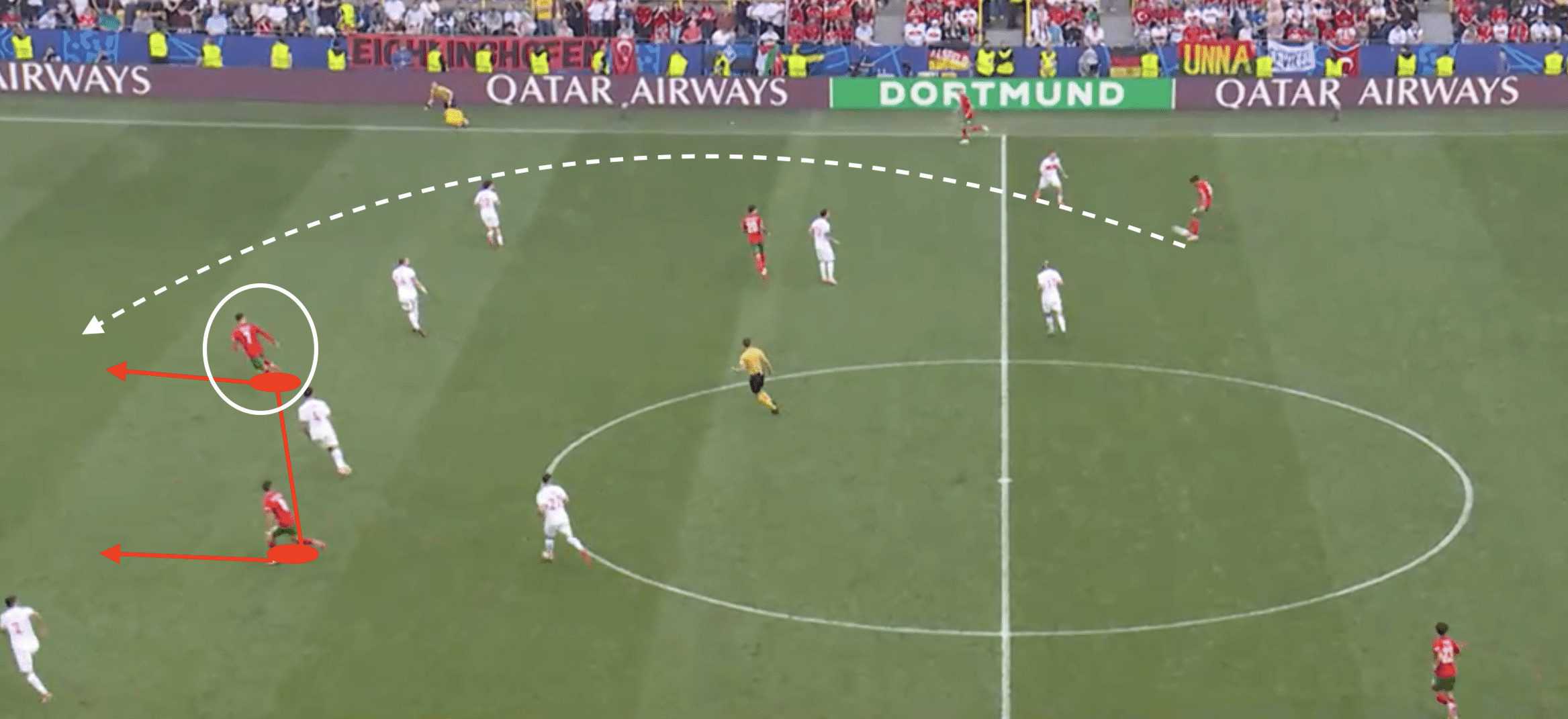
However, against Slovenia, Portugal appeared to revert to some old habits, seemingly looking to control the perimeter and consequently relieving Slovenia of pressure through the centre of the pitch.
Unlike their clash with Czechia, Portugal benefitted early on from Ronaldo’s intelligent attacking movement and the Portuguese wide men’s crafting of dangerous crossing opportunities from their wide rotations and overloads.
But their efforts were ultimately fruitless once again, with the Slovenian central defenders Bijol and Drkušić becoming wise to Ronaldo’s runs and excelling in the majority of aerial duels once crosses arrived.
Portugal’s attacking shape also allowed Slovenia to sustain their pressing efforts throughout the match due to the fact that they were able to shepherd and pin the Portuguese towards the touchline.
Slovenia were able to press in the 4-3-3, with either Čerin or Stojanović moving over to the right-hand side, which saw the majority of the Portugal build-up.
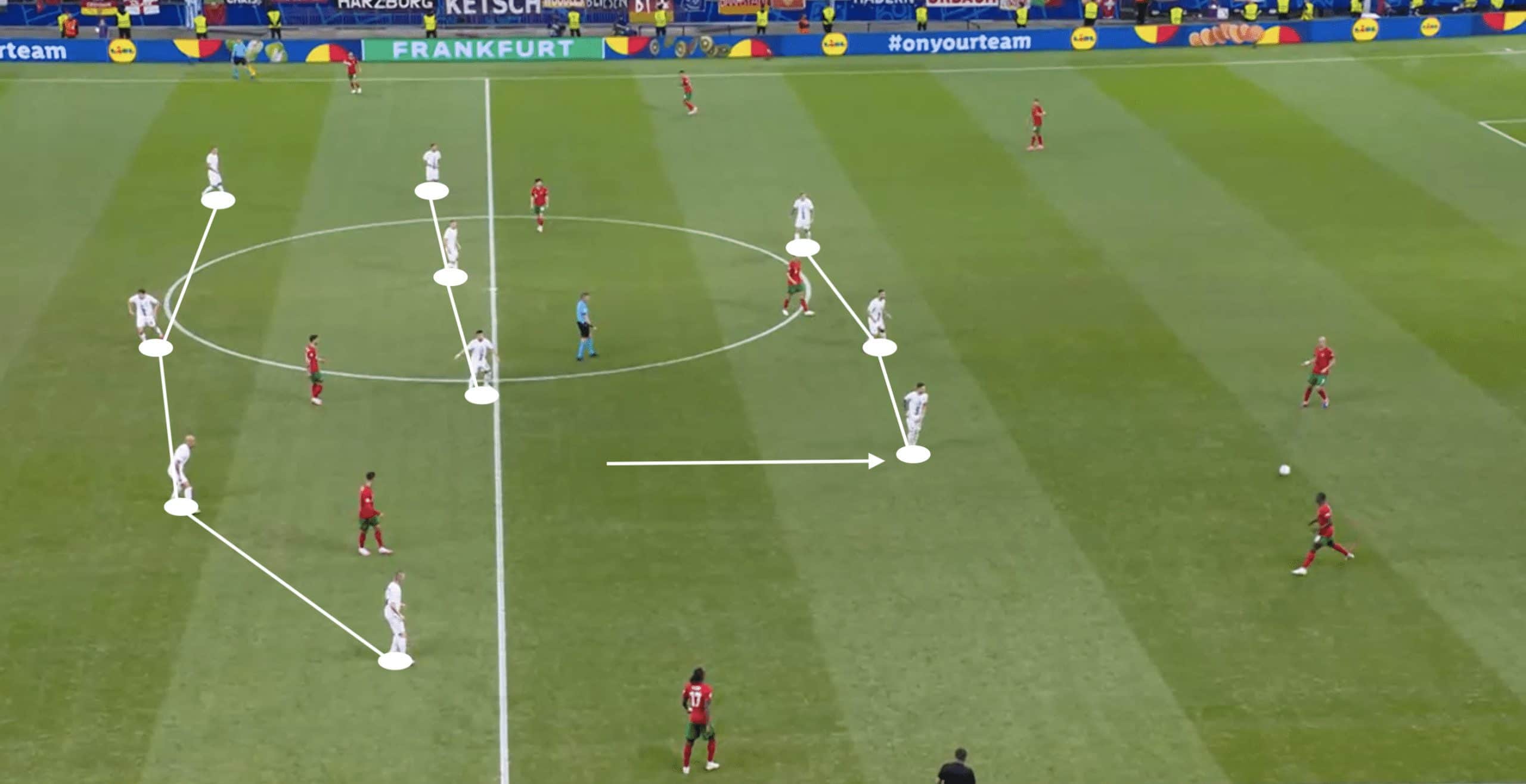
Portugal should look to hurt France through the middle of the pitch after showing glimpses of promise at times against Slovenia.
Some of their best chances arose from situations like Leão coming centrally to win the second ball and leaving the defenders in two minds as he advanced towards the goal.
The key game-changing moment in extra time will only boost Portugal’s confidence in succeeding through the middle, with Jota’s progressive run resulting in what could’ve been a match-sealing penalty goal for Ronaldo.
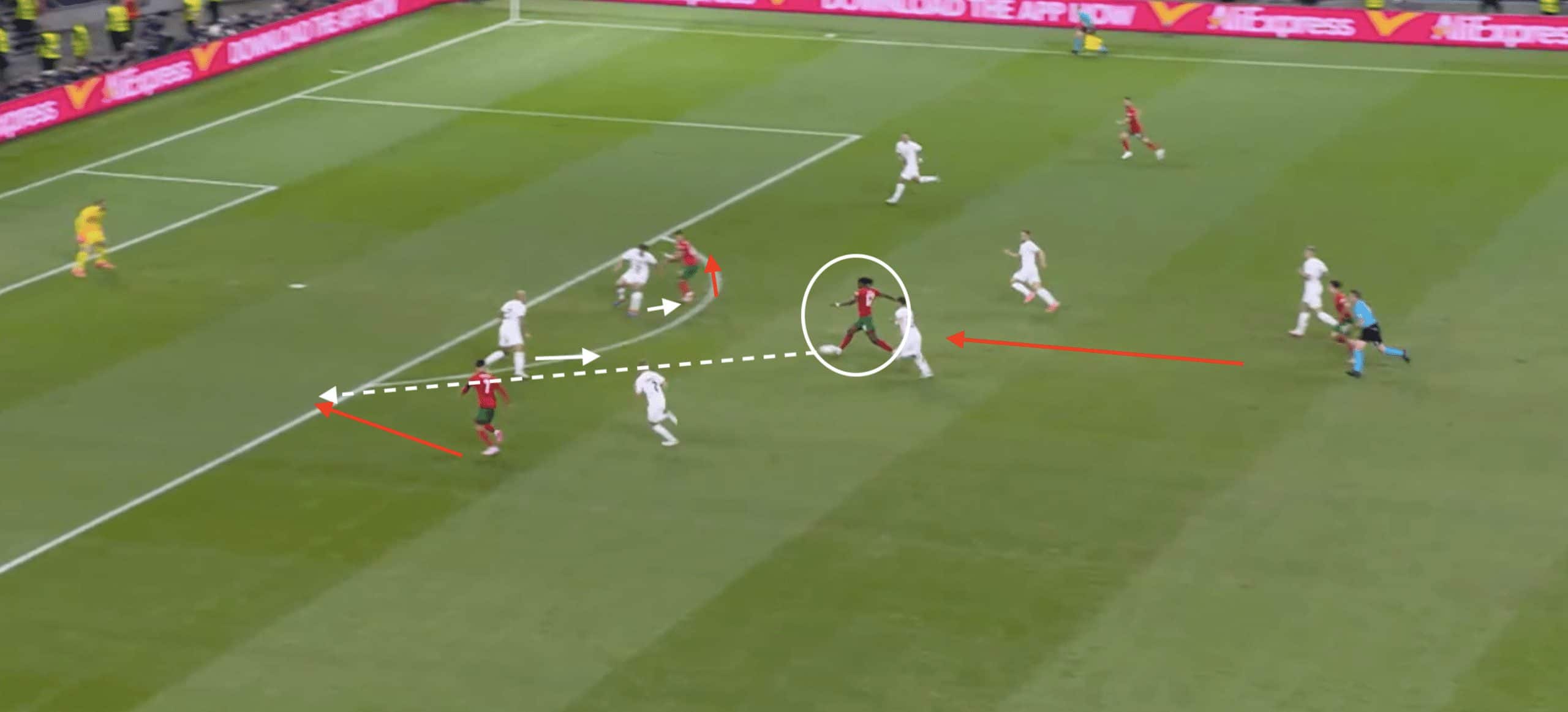
Joy from Jules
When discussing Portugal’s attacking variance and decision whether or not to focus play through the centre, it is essential to highlight how France were able to limit the threat of Belgium’s key creators and how this could be emulated in the quarter-final.
Domenico Tedesco opted for a strike partnership of Openda and Lukaku in their 4-4-2 shape, forcing De Bruyne to partner Onana in the pivot.
This played into the hands of France and Tchouaméni incredibly well, with Belgium’s attackers both wanting to play beyond the two central defenders, leaving an exceedingly large gap between the attack and midfield.
This allowed France to stunt the Belgian progression with limited options for Doku to utilise in the centre of the pitch, as shown in the example below.
Especially when Griezmann was able to support Koundé by doubling up on the Manchester City winger, the ball was often recycled back along the defensive line, with De Bruyne unable to accurately connect with Lukaku.
Once changes were made in the second half, France appeared much more vulnerable, with De Bruyne drifting between the lines, but Tchouaméni was able to nullify his threat with excellent man-marking.
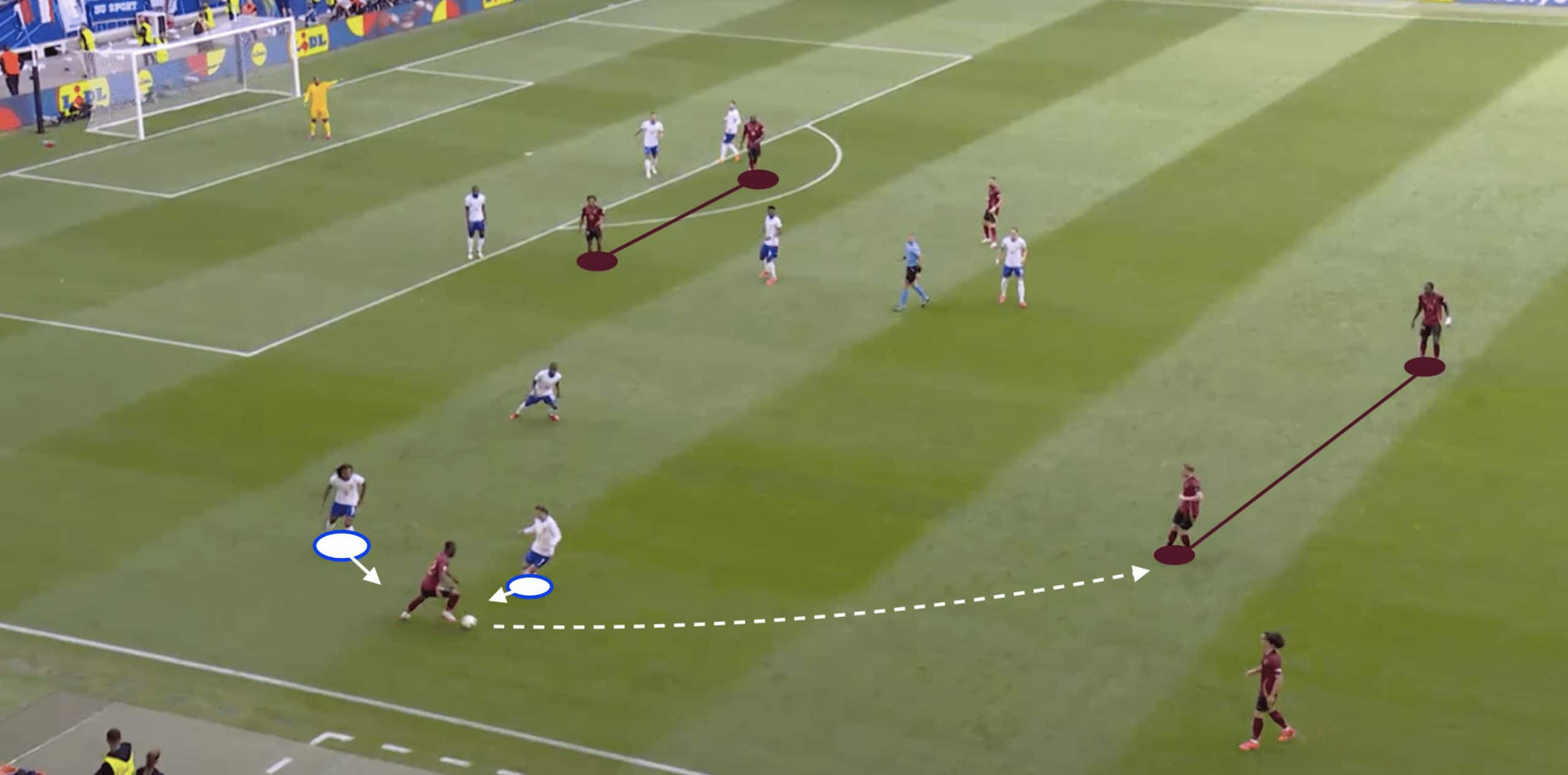
In the offensive phase, France have appeared to play with increased caution; with many suggesting that they remain shackled by the manager’s conservative approach and focus on counter-attacking.
They struggled to find success working the ball through the half-space, with Mbappé, in particular, being particularly ineffective when forced inside by the overlapping movements of both Hernández and Rabiot on the left flank.
On the right, however, France have been able to threaten due to the space Jules Koundé can create when stretching the opposition’s defence.
When overloading on the left flank, France have been able to switch the ball across the pitch through the excellent distribution of Tchouaméni; allowing Koundé to combine with Griezmann and break into the penalty area.
This was accentuated by the weaker defensive contribution of Doku, with Theate often caught out trying to shadow Griezmann as he drifted towards the right half-space.
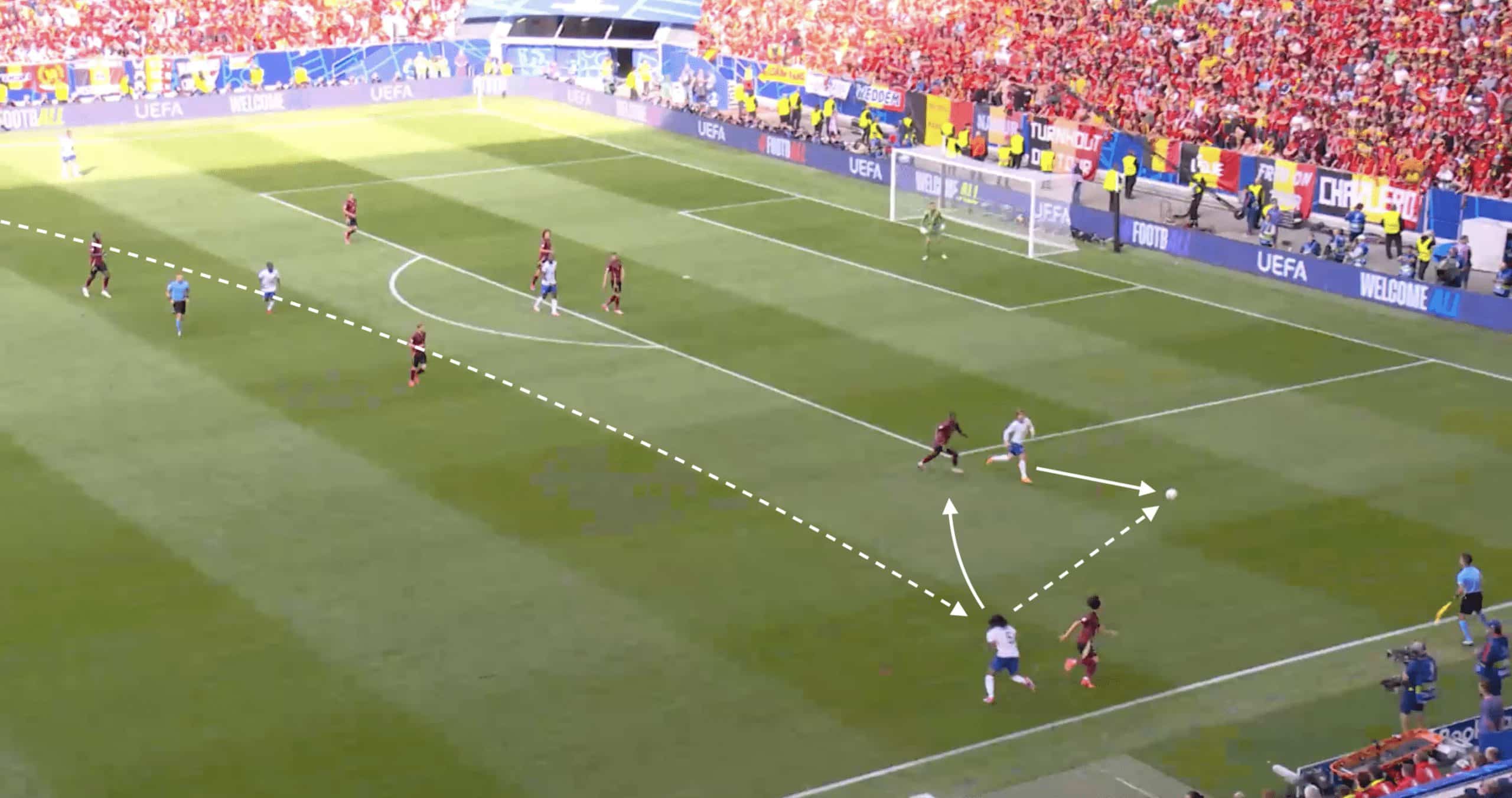
It ultimately resulted in the France breakthrough late in the match, with Hernández moving the ball inside the pitch and allowing Griezmann to find Koundé out wide- crucially unmarked as Doku was drawn towards the ball carrier.
N’Golo Kanté then provided one of the rare moments in which France were able to damage Belgium between the lines, supplying substitute Kolo Muani whose shot was deflected past the onlooking Casteels.
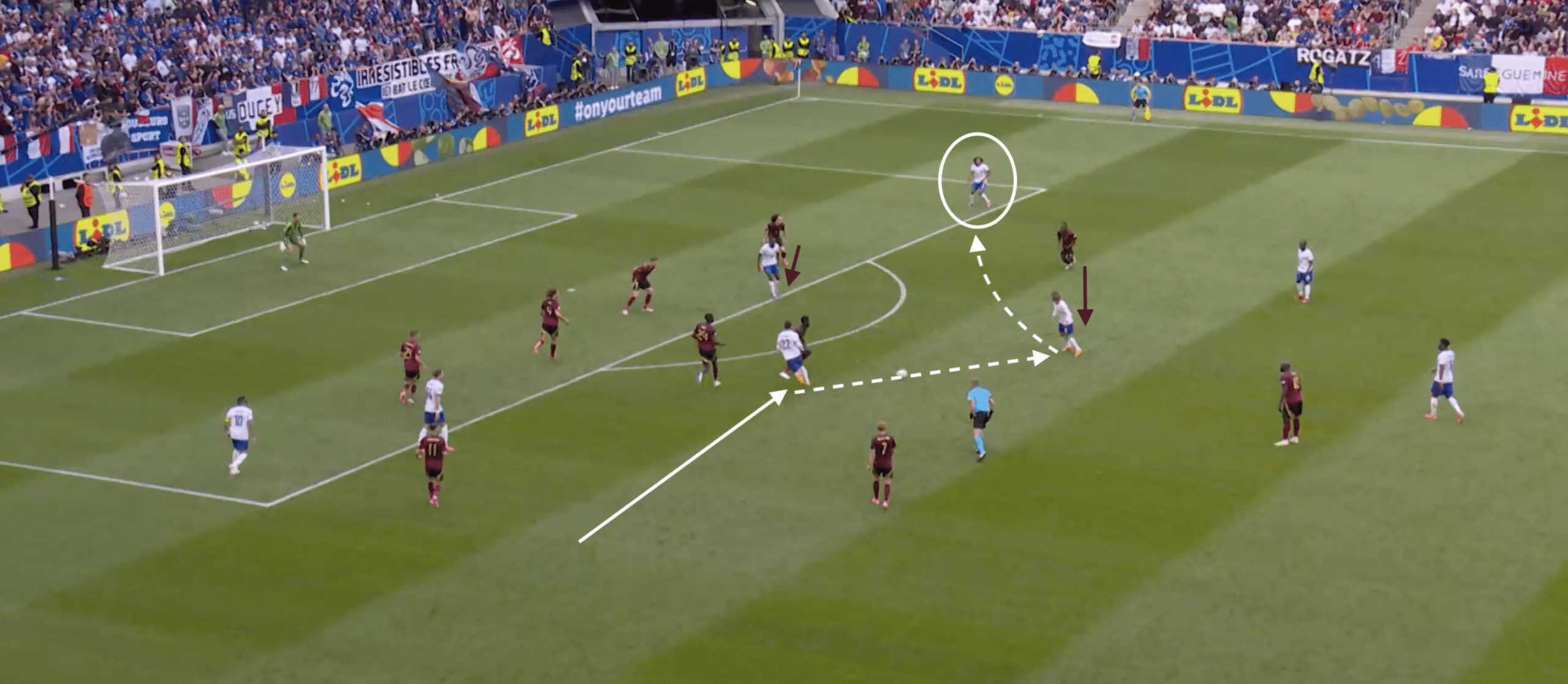
Areas to target
When observing how this phenomenal French resistance could possibly be broken, Portugal can take inspiration from Belgium in their efforts to stretch the defensive line.
Despite being limited in their attacking threat, the following example highlights how Doku was able to penetrate the France penalty area when bypassing their stern press.
With Doku finding a passing outlet through the French defensive triangle, Openda was able to spin beyond Upamecano and generate an incredibly favourable crossing opportunity to pick out Lukaku through the middle.
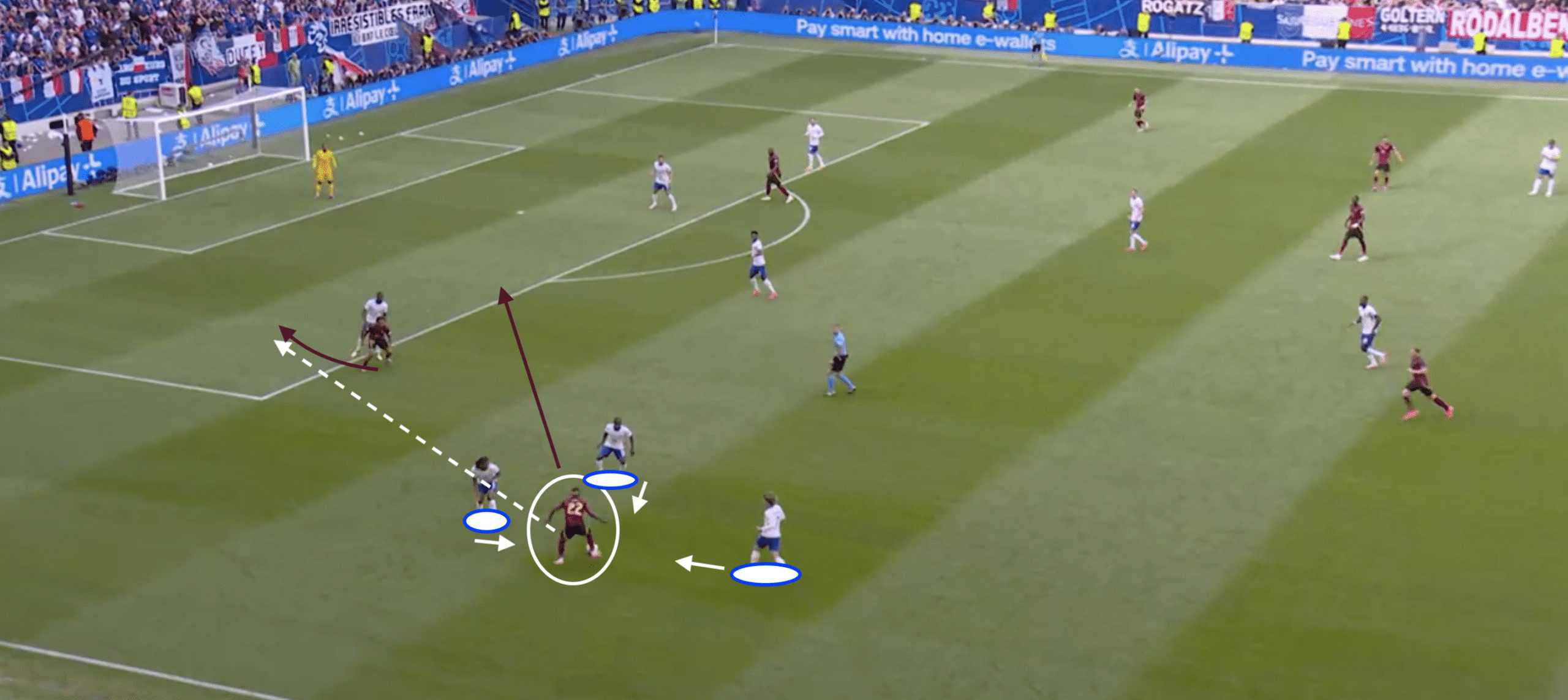
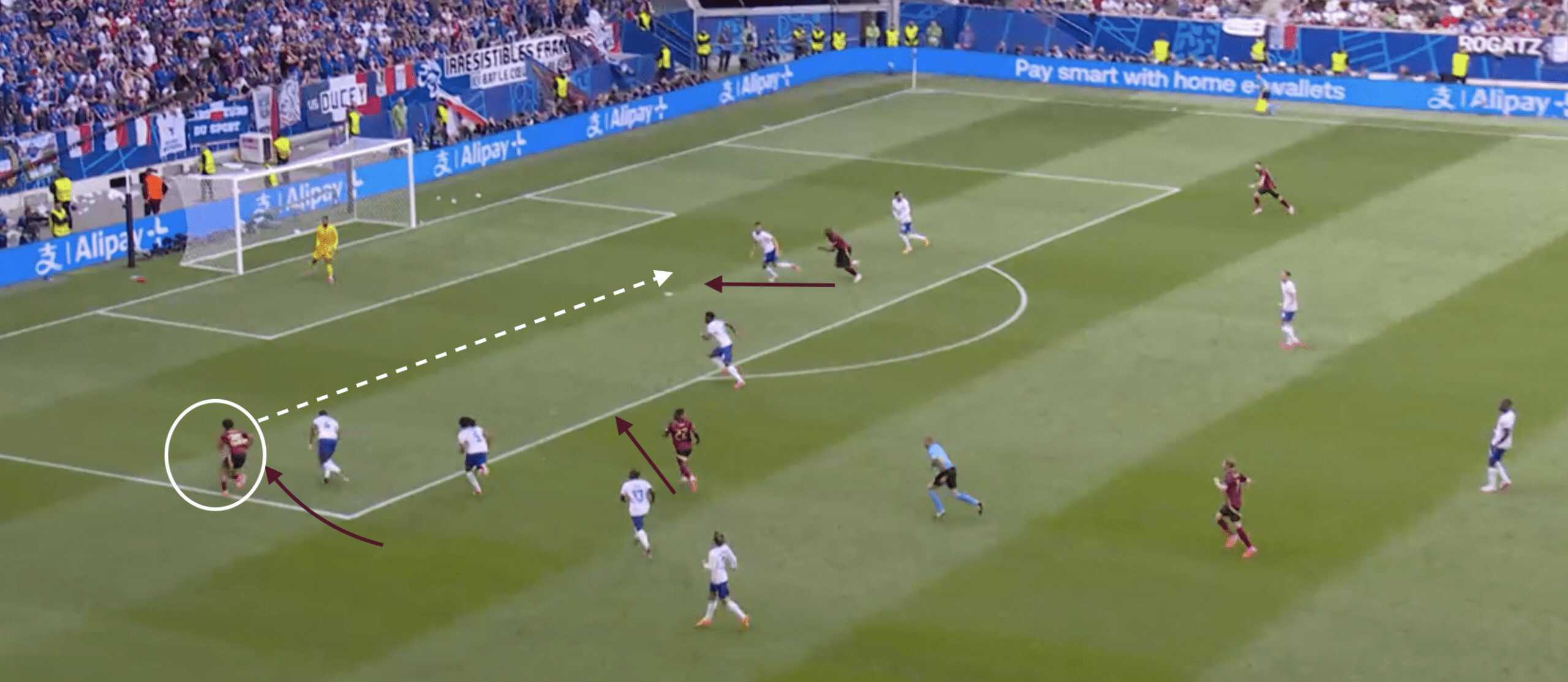
Whilst Portugal don’t exactly benefit from a consistent two-man strike partnership, the role of Openda can be emulated by one of the Portuguese wingers inverting into the half-space, or alternatively the underlapping movement of João Cancelo in particular.
This was one of the ways in which Portugal were able to unlock the Turkish defence in their second match in Group F, with the key rotations of Bernardo Silva and Cancelo increasing the width between the two Turkish central defenders, reducing pressure through the centre for Ronaldo.
For the French, it is clear that Portugal’s weaknesses lie in their transition defence, with a focus on the decreased mobility of Pepe in the back line.
Slovenia’s energetic forward, Benjamin Šeško, repeatedly aimed to capitalise on Portuguese mistakes by springing onto loose balls and stretching the verticality of Portgugal’s three-man defensive setup, resulting in multiple key opportunities.
Much like his attack-minded role at Barcelona this season, Cancelo can often be caught higher up the pitch when Portugal lose the ball in transition or when their opposition can quickly progress the ball into the final third.
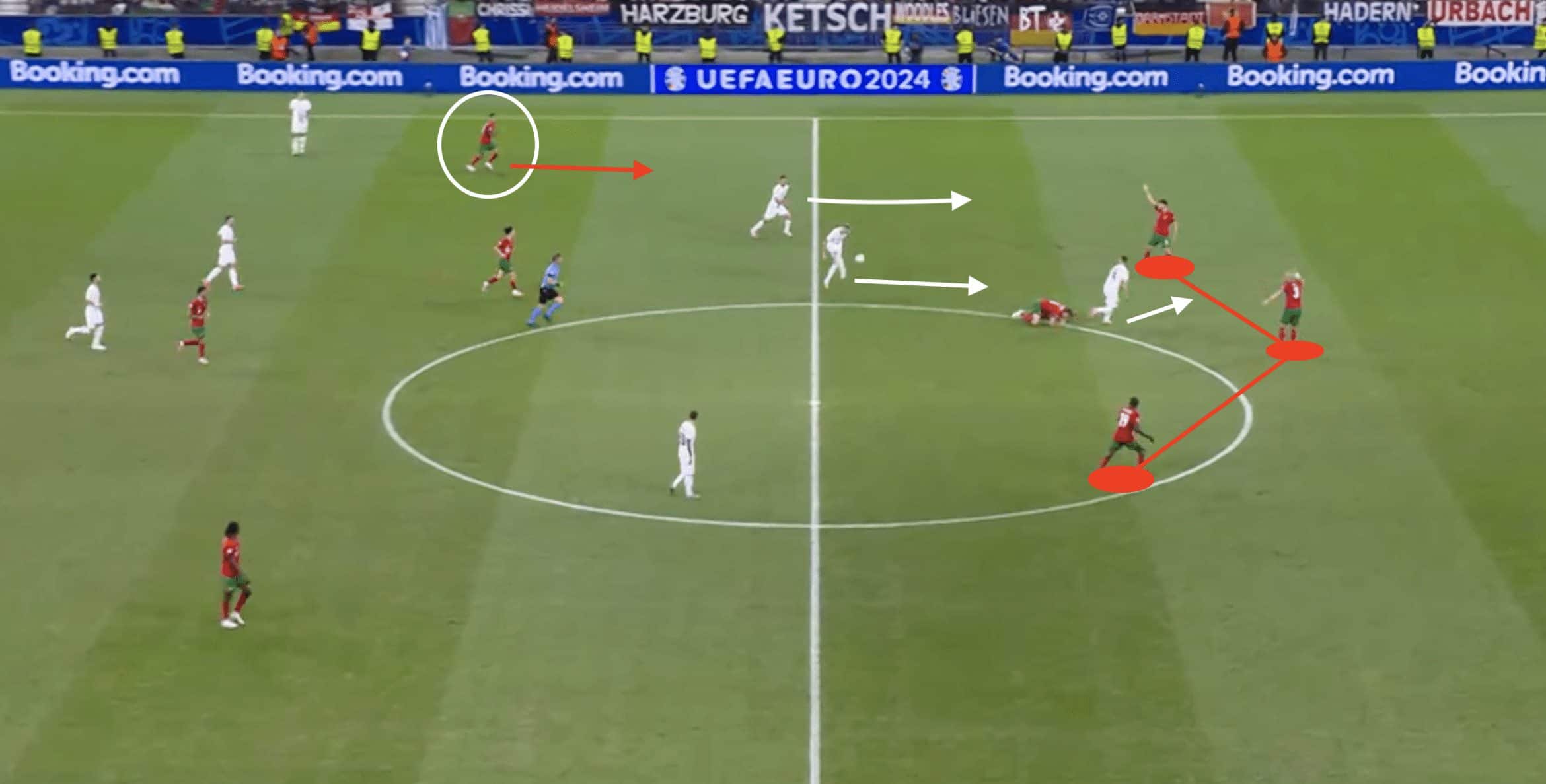
With Adrien Rabiot absent through suspension, we may see Deschamps reinstate Ousmane Dembélé on the right wing, with Antoine Griezmann dropping back into the midfield three.
This would allow France to have a clear counter-attacking threat on both wings whilst also allowing Griezmann to thrive in his role as the midfield orchestrator and key bridge between defence and attack.
Conclusion
With both sides displaying similarities in the round of 16, this upcoming quarter-final is set to be another cagey affair- defined by moments of inspiration in the attacking third.
While this French side have epitomised defensive strength throughout the tournament thus far, we will witness the first true test for the Portuguese defence; in which they can expect reduced possession and much more of a necessity to work hard off the ball.
The latest iteration of this European Championships rivalry can expect to maintain this summer’s key narratives, whether Cristiano Ronaldo can find the elusive goal to continue breaking records or if Kylian Mbappé can propel France to yet another major final.





Comments